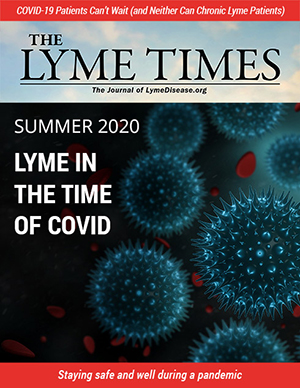In Doing Harm: The Truth about How Bad Medicine and Lazy Science Leave Women Dismissed, Misdiagnosed and Sick, author Maya Dusenbery explores gender bias in today’s medical system. This situation often leaves women without a diagnosis, with inadequate pain management, and frequently being told they are merely imagining their symptoms. Furthermore, Dusenbery asserts, the research community has largely ignored illnesses that only affect women — such as endometriosis — and pays scant attention to biological differences between women and men that can affect disease progression and drug effectiveness.
She looks at gender bias in the context of such topics as heart disease, autoimmune illnesses, and chronic pain. But the chapter that will likely resonate most with the Lyme community is the one entitled “Contested Illnesses: When Diseases Are ‘Fashionable.’” She devotes a lot of attention to Lyme disease and women in this chapter, along with other conditions that come with “medically unexplained symptoms,” such as chronic fatigue syndrome and multiple chemical sensitivities.
In the following excerpt, Dusenbery references mainstream experts who blamed “sensationalist media coverage of Lyme” for fostering an irrational fear of the disease among the overanxious “worried well.”
Excerpt from Maya Dusenbery’s “Contested Illnesses: When Diseases Are ‘Fashionable.'”
O f course, these chronic Lyme patients were stereotyped as women—specifically hypochondriacal, affluent women obsessed with every minor threat in their “suburban splendor,” as two skeptics put it. In 1991, a satirical column in Annals of Internal Medicine ridiculed them. Adopting the voice of a representative of the “Centers of Fatigue Control,” the author wrote of a new disease called “Lime disease”: “The growing national epidemic of Lime disease [paralleled] increased public awareness and knowledge of Lyme disease.” Rates of so-called Lime were “highest in adults of upper middle to upper socio-economic class, with a female-to-male sex ratio of 3:1 (in contrast to the more balanced age and sex distribution of Lyme disease),” he wrote. “Recent case-control studies of clusters of Lime disease have shown a weak to moderate association with previous attendance at cocktail parties serving lime-garnished mixed drinks, but very strong association with recent exposure to media stories on Lyme disease.”

In a 2009 article entitled “Implications of Gender in Chronic Lyme Disease,” two prominent mainstream Lyme experts dropped the satire and just made the case straight: that women’s overrepresentation among “chronic Lyme” sufferers was evidence against the idea that there is such a thing. In an argument reminiscent of the recasting of the Royal Free Hospital outbreak as a case of mass hysteria on the basis that it mostly affected women, their case went like so: since men and women are about equally likely to be diagnosed with early Lyme (with the slight edge to men), if chronic Lyme were caused by ongoing infection with B. burgdorferi, then you’d expect it also would affect both genders equally. “On the other hand, if there is a substantial difference in the gender of patients with chronic Lyme disease, it is additional evidence that this disease is unrelated to infection with B. burgdorferi.” Ergo, the fact that more women than men have a diagnosis of chronic Lyme means they probably really have fibromyalgia, CFS (conditions more common among women), or “unexplained symptoms that did not meet criteria for either fibromyalgia or chronic fatigue syndrome,” since “there is also usually a female preponderance in patients with unexplained symptoms” in general.
It would seem to be the height of circular logic to argue that Lyme infection couldn’t possibly be the explanation for some women’s “medically unexplained symptoms” because women are more likely to have “medically unexplained symptoms.”
Join or login below to continue reading.




























